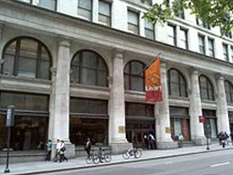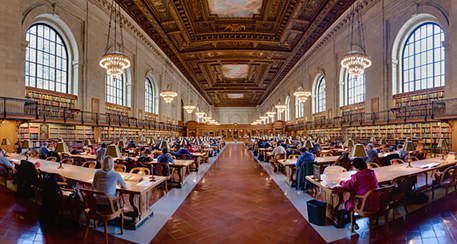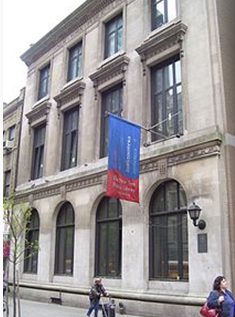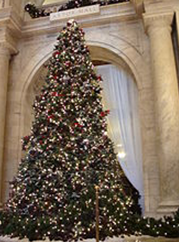
The building was declared aNational Historic Landmark in 1965.[29] Over the decades, the library system added branch libraries, and the research collection expanded until, by the 1970s, it was clear the collection eventually would outgrow the existing structure. In the 1980s the central research library added more than 125,000 square feet (12,000 m2) of space and literally miles of bookshelf space to its already vast storage capacity to make room for future acquisitions. This expansion required a major construction project in which Bryant Park, directly west of the library, was closed to the public and excavated. The new library facilities were built below ground level and the park was restored above it.
In the three decades before 2007, the building's interior was gradually renovated.[26] On December 20, 2007, the library announced it would undertake a three-year, $50 millionrenovation of the building exterior, which has suffered damage from weathering and pollution.[30] The renovation was completed on time, and on February 2, 2011 the refurbished facade was unveiled.[31] The restoration design was overseen by Wiss, Janney, Elstner Associates, Inc., whose previous projects include the Metropolitan Museum of Art's limestone facades and the American Museum of Natural History, made of granite.[32] These renovations were underwritten by a $100-million gift from philanthropist Stephen A. Schwarzman, whose name will be inscribed at the bottom of the columns which frame the building's entrances.[33] Today the main reading room is equipped with computers with access to library collections and the Internet and docking facilities for laptops. There are special rooms for notable authors and scholars, many of whom have done important research and writing at the Library.[7]
Other research branches
Even though the central research library on 42nd Street had expanded its capacity, in the 1990s the decision was made to remove that portion of the research collection devoted to science, technology, and business to a new location. The new location was the abandoned B. Altman department store on 34th Street. In 1995, the 100th anniversary of the founding of the library, the $100 million Science, Industry and Business Library (SIBL), designed by Gwathmey Siegel & Associates of Manhattan, finally opened to the public. Upon the creation of the SIBL, the central research library on 42nd Street was renamed the Humanities and Social Sciences Library.

Science, Industry and Business library
Today there are four research libraries that comprise the NYPL's research library system which hold approximately 44,000,000 items. Total item holdings, including the collections of the Branch Libraries, are 50.6 million. The Humanities and Social Sciences Library on 42nd Street is still the heart of the NYPL's research library system, but the SIBL, with approximately 2 million volumes and 60,000 periodicals, is the nation's largest public library devoted solely to science and business.[34] The NYPL's two other research libraries are the Schomburg Center for Research and Black Culture, located at 135th Street and Lenox Avenue in Harlem and the New York Public Library for the Performing Arts, located at Lincoln Center. In addition to their reference collections, the Library for the Performing Arts and the SIBL also have circulating components that are administered as ordinary branch libraries.
Recent history
Unlike most other libraries, such as the Library of Congress, the New York Public Library was not created by government statute. From the earliest days of the New York Public Library, a tradition of partnership of city government with private philanthropy began, which continues to this day.[7] As of 2010, the research libraries in the system are largely funded with private money, and the branch or circulating libraries are financed primarily with city government funds. Until 2009, the research and branch libraries operated almost entirely as separate systems, but that year various operations were merged. By early 2010, the NYPL staff had been reduced by about 16 percent, in part through the consolidations.[35]
In 2010, as part of the consolidation program, the NYPL moved various back-office operations to the new Library Services Center building in Long Island City using a former warehouse renovated for $50 million. In the basement, a new, $2.3 million book sorter uses bar codes on library items to sort them for delivery to 132 branch libraries. At two-thirds the length of a football field, the machine is the largest of its kind in the world, according to library officials. Books located in one branch and requested from another go through the sorter, which cut the previous waiting time by at least a day. Together with 14 library employees, the machine can sort 7,500 items an hour (or 125 a minute). On the first floor of the Library Services Center is an ordering and cataloging office; on the second, the digital imaging department (formerly at the Main Branch building) and the manuscripts and archives division, where the air is kept cooler; on the third, the Barbara Goldsmith Preservation Division, with a staff of 10 (as of 2010) but designed for as many as 30 employees.[35]
The NYPL maintains a force of NYC special patrolmen who provide security and protection to various libraries and NYPL special investigators who oversee security operations at the library facilities. These officials have on-duty arrest authority granted by NYS penal law; however, some library branches use contracted security guards for security.
In February 2013, it was announced that the New York Public Library and the Brooklyn Public Library would merge their technical services departments. The new department would be called Book Ops. The decision was prompted in part by a meeting with the mayor's office who suggested that merging certain activities would result in savings. The proposed merger anticipates a saving to the Brooklyn Public Library of $2 million and $1.5 million to the New York Public Library. Although not part of the immediate merger, it is expected that theQueens Library will eventually share some resources with the other city libraries.[36]
Controversies
The contraction of services and collections has been a continuing source of controversy since 2004 when David Ferriero was named the Andrew W. Mellon Director and Chief Executive of the Research Libraries.[37] NYPL had engaged consultants Booz Allen Hamilton to survey the institution, and Ferriero endorsed the survey's report as a big step "in the process of reinventing the library".[38] The consolidation program has resulted in the elimination of subjects such as the Asian and Middle East Division (formerly named Oriental Division) as well as the Slavic and Baltic Division.[39]
A number of innovations in recent years have not been without detractors.
NYPL announced participation in the Google Books Library Project, which involves a series of agreements between Google and major international libraries through which a collection of its public domain books will be scanned in their entirety and made available for free to the public online.[40] The negotiations between the two partners called for each to project guesses about ways that libraries are likely to expand in the future.[41] According to the terms of the agreement, the data cannot be crawled or harvested by any other search engine; no downloading or redistribution is allowed. The partners and a wider community of research libraries can share the content.[42]
The sale of the separately endowed former Donnell Library in mid-town has not been without its critics.[43] The elimination of Donnell also meant the dissolution of children's, young adult and foreign language collections. The Donnell Media Center was also dismantled, with parts of its collections redistributed.[44]
These changes have been justified as the road to new collaborations and new synergy,[45]however, restructuring has meant that several veteran librarians with institutional memory have left and age-level specialists in the boroughs have been cut back.[46]

A panoramic view of the Rose Main Reading Room, facing south

The Epiphany branch, on East 23rd Street in Manhattan
Branch libraries
The New York Public Library system maintains its commitment to being a public lending library through its branch libraries in The Bronx, Manhattan andStaten Island, including the Mid-Manhattan Library, The Andrew Heiskell Braille and Talking Book Library, the circulating collections of the Science, Industry and Business Library, and the circulating collections of the Library for the Performing Arts. The branch libraries comprise the third largest library in the United States.[47] These circulating libraries offer a wide range of collections, programs, and services, including the renowned Picture Collection at Mid-Manhattan Library and the Media Center at Donnell.
Of its 82 branch libraries, 35 are in Manhattan, 34 are in the Bronx, and 12 are in Staten Island.
Currently, the New York Public Library consists of 87 libraries: four non-lending research libraries, four main lending libraries, a library for the blind and physically challenged, and 77 neighborhood branch libraries in the three boroughs served. All libraries in the NYPL system may be used free of charge by all visitors. As of 2010, the research collections contain 44,507,623 items (books, videotapes, maps, etc.). The Branch Libraries contain 8,438,775 items.[48] Together the collections total nearly 53 million items, a number surpassed only by the Library of Congress and the British Library.
Taken as a whole the three library systems in the city have 209 branches with 63 million items in their collections.
Services
ASK NYPL

Christmas tree in the main entrance to the NYPL at Astor Hall
Since 1968 Telephone Reference has been an integral part of The New York Public Library's reference services, although it existed long before in a limited way. Now known as ASK NYPL,[49] the service provides answers by phone and online via chat and e-mail 24 hours a day, seven days per week. Library users can ask reference questions in Spanish and English and seek help at anytime through online chat via the Library's website. Through participation in an international cooperative, the Library receives support answering questions outside regular hours.
The service fulfilled nearly 70,000 requests for information in 2007. Inquiries range from the serious and life-changing (a New Orleans resident who lost his birth certificate in Katrina needing to know how to obtain a copy; it turns out he was born in Brooklyn), to the fun or even off-the-wall (a short-story writer researching the history of Gorgonzola cheese). In 1992 a selection of unusual and entertaining questions and answers from ASK NYPL was the source for Book of Answers: The New York Public Library Telephone Reference Service's Most Unusual and Entertaining Questions, a popular volume published by Fireside Books. National and international questioners have included scores of newspaper reporters, authors, celebrities, professors, secretaries, CEOs, and everyone in between.
In 2008 The New York Public Library's ASK NYPL reference service introduced two enhancements that improve and expand the service.
The Library recently launched 917-ASK-NYPL, a new easier to remember telephone number for Library information and for asking reference questions. Every day, except Sundays and holidays, between 9:00 am and 6:00 pm EST/EDT, anyone, of any age, from anywhere in the world can telephone 917-275-6975 and ask a question. The library staff will not answer crossword or contest questions, do children's homework, or answer philosophical speculations.[50]



















